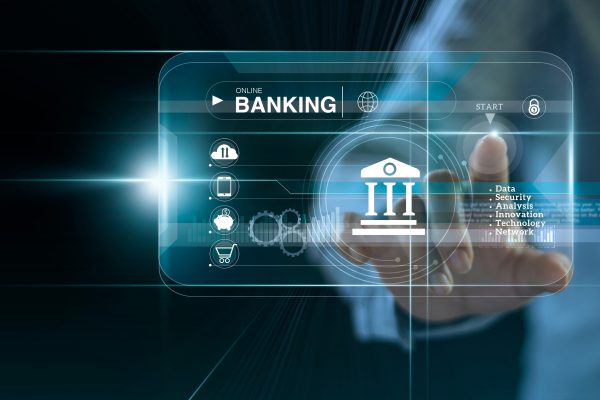Home>Finance>The Digital Banking Revolution: How Consumer Preferences are Shaping the Future of Finance


Finance
The Digital Banking Revolution: How Consumer Preferences are Shaping the Future of Finance
Published: November 19, 2023
Explore how digital banking has revolutionized the financial industry and transformed consumer preferences. Learn the impact that this shift is having on traditional banking practices and what the future of finance may look like.
(Many of the links in this article redirect to a specific reviewed product. Your purchase of these products through affiliate links helps to generate commission for LiveWell, at no extra cost. Learn more)
In the rapidly evolving world of finance, digital banking has emerged as a transformative force, reshaping the traditional banking landscape. This shift towards digital platforms has revolutionized the way customers interact with financial institutions, offering unprecedented levels of convenience and efficiency.
Overview of Digital Banking
Digital banking represents the integration of banking services with digital technology. It marks a significant shift from traditional, physical banking methods to online and mobile platforms. This evolution began with the introduction of Automated Teller Machines (ATMs) and online banking in the late 20th century, evolving into today’s comprehensive digital banking services accessible via smartphones and computers. Digital banking includes a wide array of services such as online fund transfers, digital payments, mobile check deposits, and real-time account management.
Impact of Technology on Banking
The technological revolution in banking, driven by advancements in Artificial Intelligence (AI), Machine Learning (ML), Blockchain, and cybersecurity, has been pivotal in the digital banking revolution. AI and ML have enabled personalized banking experiences and efficient customer service through chatbots and predictive analytics. Blockchain technology has introduced a new level of security and transparency in transactions, particularly in areas like international transfers and identity verification. Moreover, the emphasis on cybersecurity has become paramount, with banks adopting advanced measures like biometrics and encryption to protect customer data. These technological advancements have not only enhanced the efficiency and security of banking services but also significantly improved customer experience.
The Shift in Consumer Preferences
Growing Preference for Digital Services
The consumer banking landscape is witnessing a significant shift towards digital services. Customers are increasingly favoring digital banking platforms for their convenience, speed, and accessibility. This trend is evident in the growing use of online and mobile banking tools for everyday financial tasks like checking balances, transferring funds, and paying bills. The preference for digital channels is not just limited to transactional activities but extends to complex financial services like loan applications and investment management. This shift is largely driven by the digital-first approach of consumers who seek efficiency and flexibility in their banking experiences.
Generational Influence
The adoption and usage of digital banking vary significantly across different generations. Gen Z and Millennials are at the forefront of embracing digital banking, heavily relying on mobile apps and online platforms for their financial transactions. This tech-savvy generation values the convenience and immediacy that digital banking offers. On the other hand, Baby Boomers tend to be more cautious, often preferring a mix of traditional and digital banking methods. They may use digital platforms for basic transactions but often rely on physical branches for more complex banking needs. Understanding these generational differences is crucial for banks to tailor their services and engage effectively with each demographic.
Pandemic’s Acceleration of Digital Banking
The COVID-19 pandemic has acted as a catalyst in accelerating the adoption of digital banking. With lockdowns and social distancing norms, consumers and financial institutions alike were compelled to rapidly adopt and enhance digital channels. This period saw a significant increase in first-time users of digital banking services, with many customers experiencing the benefits of online and mobile banking firsthand. The pandemic also pushed banks to expedite the development of their digital infrastructure to meet the growing demand. This acceleration is likely to have a lasting impact on banking behaviors, with a continued preference for digital solutions even post-pandemic.
Trends in Digital Banking
Rise of Mobile Banking
The growth of mobile banking represents a significant trend in the digital banking landscape. Mobile banking apps have become increasingly sophisticated, offering a wide range of features beyond basic account management. These apps now include functionalities like mobile check deposits, real-time notifications, budgeting tools, and even financial advice. The convenience of managing finances on the go has led to a surge in mobile banking usage, with many consumers preferring mobile apps over traditional online banking. The integration of mobile payment systems like Apple Pay and Google Pay has further enhanced the mobile banking experience.
Neobanks and Challenger Banks
The emergence of neobanks and challenger banks is a disruptive trend in the financial sector. These digital-only banks, free from the constraints of traditional banking infrastructure, offer streamlined, user-friendly banking experiences. They often provide lower fees, higher interest rates, and innovative features that appeal to tech-savvy consumers and those disillusioned with conventional banks. Neobanks like Revolut, Monzo, and N26 have gained significant traction, challenging established banks and reshaping market dynamics. Their impact is particularly noticeable in the way they have forced traditional banks to accelerate their digital transformation efforts.
Personalization and AI
Artificial Intelligence (AI) is playing a crucial role in enabling personalized banking experiences. Banks are leveraging AI to analyze customer data and provide tailored services, such as personalized financial advice, customized product recommendations, and individualized customer support through AI-driven chatbots. This level of personalization enhances customer engagement and satisfaction, fostering a deeper connection between banks and their customers. AI’s predictive capabilities also enable banks to anticipate customer needs and offer proactive solutions, further personalizing the banking experience. The use of AI in banking is not just a trend but a fundamental shift towards more customer-centric banking services. McKinsey’s report on AI in banking provides comprehensive insights into how AI is transforming personalization in the financial sector.
Consumer Insights from Surveys and Studies
Key Findings from PwC’s 2021 Digital Banking Consumer Survey
PwC’s 2021 Digital Banking Consumer Survey provides critical insights into the evolving preferences and behaviors of banking customers. Key findings indicate a significant shift towards digital banking, with a notable increase in consumers preferring digital-only interactions. The survey highlights that younger generations, particularly Gen Z and Millennials, are leading this shift, showing a strong preference for digital banking solutions. Additionally, the survey reveals a growing openness among consumers to switch to digital-only banks, indicating a potential challenge for traditional banking institutions. These trends underscore the importance for banks to invest in and enhance their digital platforms to meet these changing consumer preferences.
Consumer Behavior and Digital Banking
Consumer behavior is increasingly influencing banking strategies, as banks strive to align their services with customer expectations in the digital age. The demand for convenience, speed, and personalized experiences is driving banks to innovate and adopt new technologies. Customers now expect seamless digital experiences, similar to what they encounter in other sectors like e-commerce and online entertainment. This shift in consumer behavior is pushing banks to focus on user-friendly interfaces, enhanced mobile experiences, and personalized financial advice through AI and data analytics. Banks are also recognizing the need for robust security measures to build and maintain consumer trust in digital platforms.
Challenges and Opportunities
Security Concerns in Digital Banking
Cybersecurity and data protection remain paramount challenges in the realm of digital banking. As banking services increasingly move online, the risk of cyber threats, such as hacking, phishing, and identity theft, escalates. Banks are continuously investing in advanced security technologies like encryption, biometrics, and secure sockets layer (SSL) protocols to safeguard customer data. Additionally, educating customers about safe digital banking practices is crucial in mitigating these risks. The implementation of robust cybersecurity measures is not just a technical necessity but also essential for maintaining customer trust in digital platforms. For more detailed insights into cybersecurity in digital banking, Kaspersky’s cybersecurity report offers valuable information.
Bridging the Digital Divide
Ensuring the accessibility of digital banking services to all segments of society is a significant challenge and opportunity. The digital divide – the gap between those who have access to digital technologies and those who do not – can limit the reach and benefits of digital banking. Financial institutions are tasked with creating inclusive digital solutions that cater to diverse populations, including those with limited access to technology or digital literacy. This involves developing user-friendly platforms, offering multilingual support, and providing alternative access methods for those without smartphones or internet access. Bridging this divide is crucial for achieving comprehensive financial inclusion. The World Bank’s report on financial inclusion provides a broader perspective on this challenge.
Regulatory Landscape for Digital Banking
The regulatory landscape plays a critical role in shaping the digital banking environment. Regulations are essential for ensuring the safety, reliability, and integrity of digital banking services. As digital banking continues to evolve, regulatory bodies worldwide are updating and introducing new guidelines to address emerging challenges, such as data privacy, consumer protection, and cybersecurity. Compliance with these regulations is vital for banks to operate legally and maintain customer confidence. However, navigating this ever-changing regulatory landscape can be complex for financial institutions.
The Future of Digital Banking
Predictions for Digital Banking
The future of digital banking is poised for continued growth and transformation. Current data and market analysis suggest several key trends. Firstly, the integration of AI and ML in banking services is expected to deepen, leading to more sophisticated personalization and predictive banking services. Secondly, the use of blockchain technology is likely to expand beyond cryptocurrencies, enhancing security and efficiency in transactions. Thirdly, the rise of neobanks and digital-only banking platforms is anticipated to continue, further disrupting the traditional banking model. Additionally, there’s an expected increase in the adoption of open banking, allowing for more seamless integration of third-party financial services. These trends collectively point towards a more interconnected, efficient, and customer-centric banking ecosystem. For a detailed forecast, Accenture’s Banking Technology Vision 2021 provides an in-depth analysis of future trends in digital banking.
Innovations on the Horizon
Upcoming technological advancements in digital banking are set to redefine the industry. One significant innovation is the advancement in voice-assisted banking, which is expected to make digital banking more accessible and convenient. Another area of innovation is the development of more advanced biometric security measures, such as facial recognition and vein pattern recognition, enhancing the security of digital transactions. Additionally, the integration of augmented reality (AR) and virtual reality (VR) in banking apps could revolutionize customer experience, offering immersive ways to interact with financial services. Furthermore, the growth of Internet of Things (IoT) technology is likely to lead to more interconnected banking ecosystems, where various devices can seamlessly integrate and communicate for enhanced banking services. These innovations, among others, are set to further advance the capabilities and reach of digital banking.
Impact on Traditional Banking
Transformation of Traditional Banks
Traditional banks are undergoing a significant transformation to adapt to the digital age. This adaptation involves not just the introduction of online and mobile banking services, but a complete overhaul of their business models to stay competitive. Traditional banks are investing heavily in digital infrastructure, adopting technologies like cloud computing and AI to enhance efficiency and customer experience. They are also forming partnerships with fintech companies to leverage innovative technologies and expand their service offerings. This transformation is crucial for traditional banks to meet the evolving expectations of digital-savvy customers and to compete effectively with emerging digital-only banks.
The Role of Physical Bank Branches
The role of physical bank branches is evolving in the digital era. While the rise of digital banking has reduced the frequency of in-branch visits, physical branches are not becoming obsolete. Instead, their role is shifting from transactional centers to advisory hubs. Branches are increasingly focusing on providing value-added services such as financial advice, complex product offerings, and personalized customer service. This shift is part of a broader omnichannel strategy, where banks aim to provide a seamless experience across digital and physical channels. The future of bank branches will likely involve a blend of technology and personal touch, with digital tools enhancing the efficiency and effectiveness of in-person interactions. For further insights into the changing role of bank branches, Deloitte’s analysis of the future of banking provides valuable perspectives.
Strategic Implications for Financial Institutions
Adapting to Digital Preferences
For banks to thrive in the digital era, adapting to digital preferences is not just an option, but a necessity. This adaptation involves more than just offering online services; it requires a fundamental shift in how banks operate and engage with customers. Key strategies include investing in advanced digital infrastructure, such as cloud computing and data analytics, to improve service delivery and operational efficiency. Banks also need to prioritize mobile-first strategies, recognizing the growing preference for mobile banking among consumers. Additionally, embracing innovations like AI for personalized services and blockchain for secure transactions can significantly enhance digital offerings. Collaborations with fintech companies can also provide access to cutting-edge technologies and innovative business models.
Customer-Centric Approaches
In digital banking, a customer-centric approach is crucial for success. This approach involves understanding and anticipating customer needs and preferences to provide tailored banking experiences. Banks must leverage data analytics to gain insights into customer behavior and preferences, enabling them to offer personalized products and services. It’s also important to ensure user-friendly interfaces across all digital platforms, making banking accessible and convenient for all customer segments. Engaging with customers through their preferred channels and providing responsive customer support are also key aspects of a customer-centric strategy. Additionally, banks should focus on building trust by ensuring transparency and robust security measures in their digital services. For more information on customer-centric approaches in banking, Forrester’s research offers valuable insights into enhancing customer experience in the digital banking sector.
Conclusion
The digital banking revolution is fundamentally reshaping the financial landscape, signaling a shift towards a more interconnected, efficient, and customer-focused banking experience. This transformation is driven by technological advancements such as AI, blockchain, and mobile technology, which have not only enhanced the efficiency and security of banking services but also significantly improved customer experience. The rise of digital banking has led to the emergence of neobanks and challenger banks, further intensifying competition and innovation in the sector. Traditional banks are responding by undergoing digital transformations, integrating advanced technologies, and adopting customer-centric approaches. The future of banking is poised to be more digital, personalized, and accessible, with continuous innovations shaping the way financial services are delivered. This revolution is not just changing how banks operate but also how customers interact with their financial institutions, setting the stage for a new era in banking.













